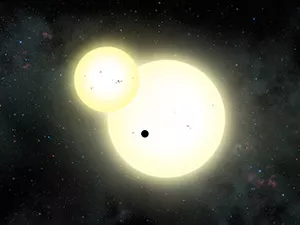Astronomer Eric Jensen Helps to Confirm Discovery of New 'Tatooine' Planet

Jensen, colleagues, and students have published on about 12 other discoveries through observations in the Van de Kamp Observatory in recent years. Photo by Assistant Professor of Physics Tristan Smith
A worldwide network of astronomers, including Professor of Astronomy Eric Jensen, announced this week the discovery of the largest circumbinary planet ever found.
The recently identified planet, Kepler-1647b, is approximately 3,700 light years away, 4.4 billion years old, and nearly identical to Jupiter in mass and radius. The observations of Jensen and an amateur astronomer in Portugal helped to confirm its existence.
“It’s really exciting for me to be a part of this discovery, since I’ve been working on this problem for a long time,” says Jensen, who is also the director of The Aydelotte Foundation. He could only have imagined that the dusty disks around young binary stars that he studied as a graduate student would one day form planets.
“At the time, to seriously discuss that possibility seemed a little wacky, like you were over-hyping things,” he adds. “I never thought I would one day help discover a circumbinary planet.”

Artist's impression of the simultaneous stellar eclipse and planetary transit events on Kepler-1647. Such a double eclipse event is known as a syzygy. Figure credit: Lynette Cook
Planets that orbit two stars are known as circumbinary planets or, sometimes, “Tatooine” planets, after Luke Skywalker’s home in Star Wars. Using NASA’s Kepler telescope, astronomers search for slight dips in brightness that suggest a planet may be moving in front of a star and blocking a bit of its light.
A team at NASA’s Goddard Space Flight Center and San Diego State University discovered Kepler-1647b with the telescope. To verify their finding, the astronomers turned to the KELT Follow-Up Network, which consists of 40 professional and amateur astronomers in ten countries across four continents.
Through its observations, the NASA team discerns patterns that help it to predict events such as a planet passing in front of its two stars, or an eclipse of the stars themselves. But to see the full picture, the team needs to have many eyes in the field.
“If you’re expecting something at a particular time and it happens to be daylight where you are, you can’t observe it,” says Jensen. “The more telescopes you have distributed around the world, the more you can capture things whenever they happen.”
In 2013, the NASA astronomers alerted the KELT Network to a likely event with Kepler-1647b. Jensen programmed the telescope to take several hundred images that measured the stars’ brightness, and detailed analysis of the data revealed that the stars had, in fact, eclipsed each other at the time predicted by the team, using a model that included the effects of the planet on the stars.
Jensen and the astronomer from Portugal, Joao Gregorio, are listed as co-authors on research (PDF) that will be published by The Astrophysical Journal. The KELT Follow-Up Network offered its findings on the new planet at the American Astronomical Society meeting in San Diego, Calif., this week.
Jensen joined the KELT network through a connection to its creator, astronomer Joshua Pepper of Lehigh University, who sought to "crowdsource" observational data. Jensen and Professor of Astronomy David Cohen have served the project from the Science Center’s Van de Kamp Observatory for several years, incorporating students into the process for observations and data analysis.
Swarthmore faculty and students have participated in about 12 other published planet discoveries, including KELT-1b and KELT-2Ab. They have several other projects underway, says Jensen, and several hundred more candidate star systems that may host planets to observe.
“To connect all of this, the 1,000 planets around other stars that we know of now, back to when I first started in the field — holy cow!” says Jensen. “It’s been pretty cool to see this develop over time.”
Read more about Jensen's contribution to the discovery at WHYY Newsworks and more about Kepler-1647b at The Washington Post.



